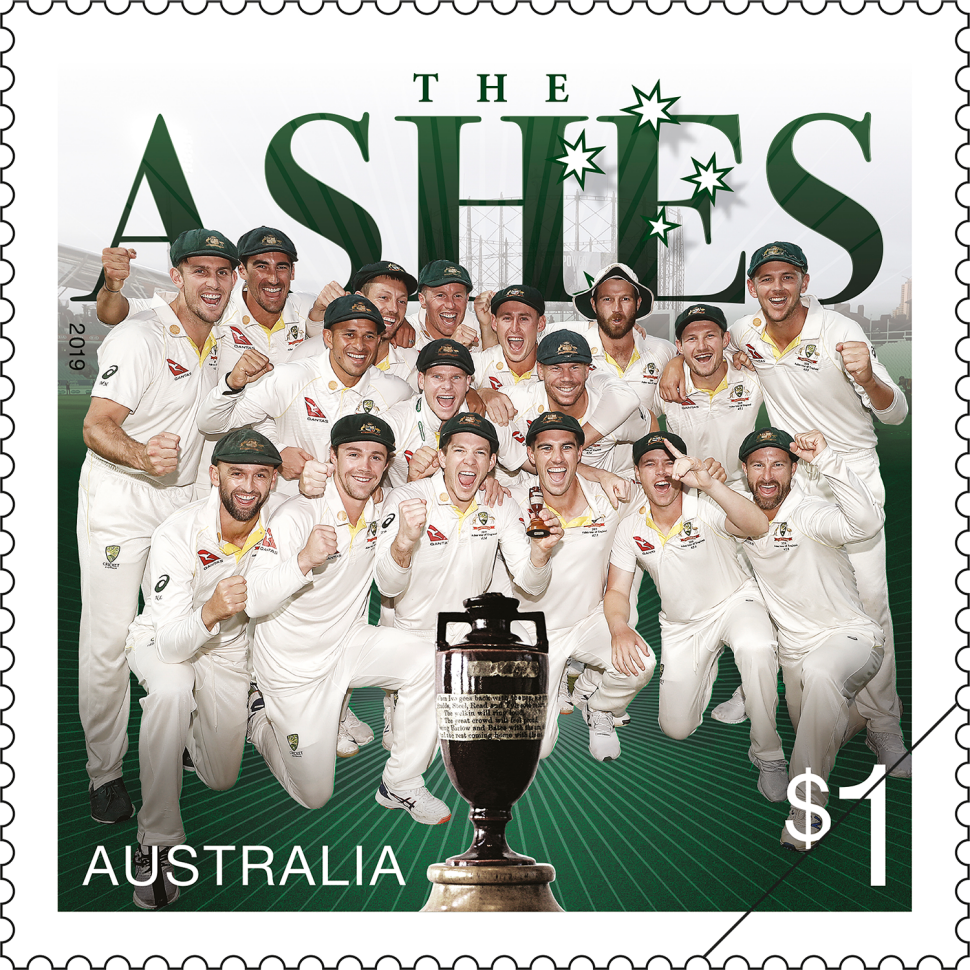Cricket first appeared on a stamp in 1962 – a batsman poised with willow at the wickets – immortalised on a diamond-shaped stamp from Cape Verde (Portugal). A little more than a decade later, in 1974, Australia released its first cricket stamp, one among five showing popular sports that comprise our sporting landscape. Since that issue and including this one, Australia has represented the cricket on 11 occasions, with a total of 21 stamps.
This stamp issue – a single instant stamp – is the third to honour the historic Ashes series, released to mark Australia’s possession of the hallowed urn. For those that didn’t have their ear to the radio or eye to the telly, this year’s series took place during August–September in England, with the five test matches held at Edgbaston, Lord’s, Headingley, Old Trafford and the Oval. Australia went into the 2019 series as defender of the trophy, having won in 2017–18, when the Ashes series took place in Australia between November and January. In what has been viewed as a highly entertaining series, the 2019 Ashes closed with a draw, a result that hasn’t been seen for nearly 50 years. That draw saw Australia retain the Ashes, a fate that was sealed when it won the fourth test at Old Trafford, Manchester, by 185 runs.
The origins of the Ashes can be traced back to August 1882. In an historic match between the English and visiting Australians – in a game with extraordinary turns of fate – Australia beat the home side at the Oval in a match that looked unlosable for the English. By week’s end, the Sporting News had published a satirical obituary, penned by Reginald Shirley Watkinshaw Brooks, claiming that English cricket was dead and that its body would be cremated and the ashes taken to the distant homeland of the victorious.
The funereal symbolism deepened when the English visited the colonies some months later in an effort to regain the ashes. Under Ivo Bligh, the English did indeed take out the test series, winning the first and fourth matches. But it was the revelry of a group of Melbourne women during the tour that realised the metaphor behind the challenge. After a friendly Christmas match at Sunbury that was won by the visiting English, the women presented Bligh with a small terracotta urn. This was apparently filled with the charred remains of either the bails or the ball from the game in which they’d triumphed. Bligh returned to England with the small urn of ashes – also with a promise of marriage from Florence Morphy, one of the women responsible for the urn.
Two years after her husband died in 1927, Dame Florence Bligh presented the ashes to the Marylebone Cricket Club (MCC), England’s premier cricket club. The fragile urn is kept permanently in the collection of MCC museum, and since the 1998–99 series, a Waterford crystal trophy has been presented to the winner of the Ashes series. Over the history of the test match series, England has won the Ashes 32 times and Australia 33 times. The series has been drawn on six occasions, with Australia retaining the Ashes on five of those occasions.
The Ashes 2019 stamp issue is available from 1 October 2019, online, at participating Post Offices and via mail order on 1800 331 794, while stocks last.
View the gallery and technical details from this issue
This content was produced at the time of the stamp issue release date and will not be updated.
You might also like





